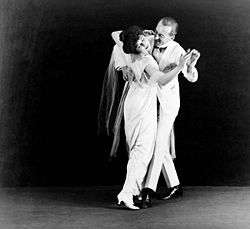Frame (dance)

Frame is the body shape maintained by dancers during partner dancing.[1] Specifically, frame refers to the shape of the upper body of the dancers relative to the rest of the dancer's body and the body of the dancer's partner.
The frame provides connection between the dance partners, making leading and following possible. A frame is a stable structural combination of both bodies maintained through the dancers' arms and/or legs, and allows the leader to transmit body movement to the follower, and for the follower to suggest ideas to the leader.
Connection occurs in both open and closed dance positions (also called "open frame" and "closed frame"). It is essential in most partner dances, but especially so in modern ballroom dance.
The required frame varies according to the dance—in street Latin style dances such as salsa, arms are held more loosely.
References
- ↑ Joseph Daniel DeMers (2013), Frame matching and ΔpTed: a framework for teaching Swing and Blues dance partner connection, Research in Dance Education, 14:1, 71 - 80, DOI: 10.1080/14647893.2012.688943